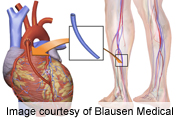
TUESDAY, Oct. 15 (HealthDay News) — Generally, the less invasive a surgical procedure is, the better. But, that’s not necessarily true for people with diabetes.
Recent research has found lower death rates and fewer heart attacks in people with diabetes who’ve undergone the open-heart procedure known as a coronary artery bypass graft (CABG), compared to those who had the less-invasive coronary angioplasty with stents. Angioplasty is also called percutaneous coronary intervention (PCI).
Now a new study of the same group of patients reports that they also have a better quality of life after the more-invasive bypass procedure.
“Recovery and early quality of life was better immediately with PCI, which is not surprising given the much less invasive nature of that procedure. But, between six months and two years, there was less [chest pain], slightly better physical performance and quality of life with CABG,” said senior study author Dr. David Cohen, director of cardiovascular research at St. Luke’s Mid America Heart Institute, in Kansas City, Mo.
Results of the study were published in the Oct. 16 issue of the Journal of the American Medical Association.
Angioplasty is a common procedure to open up blocked blood vessels that supply blood to the heart. A special balloon-tipped catheter is inserted into a blood vessel (usually in the leg), and then threaded up to the area around the heart. If a blockage is encountered, it can be opened by inflating the balloon. To keep the blood vessel open, doctors often insert a small lattice-like tube (stent) into the blood vessel, the American Heart Association explains.
In coronary artery bypass graft surgery, a surgeon takes blood vessels from other parts of the body and uses these to reroute blood flow around the blocked blood vessel. While this surgery is very effective, it is more invasive than angioplasty and requires more recovery time both in and out of the hospital.
Several previous studies have shown that bypass surgery is generally the preferred procedure for people with diabetes. Cohen said there are a number of reasons why the more-invasive procedure is better. “People with diabetes tend to have different anatomy and more co-morbidities [other existing health conditions]. Their blood vessels tend to be smaller; they have more peripheral vascular disease and more renal [kidney] failure, which are things known to be bad for those undergoing PCI,” he pointed out.
A diabetes expert explained why the less-invasive treatment isn’t necessarily the best option.
“PCI tends to fix only a little bit at a time, but people with diabetes have very diffuse disease,” said Dr. Joel Zonszein, director of the clinical diabetes center at Montefiore Medical Center in New York City. “It’s usually not one single blood vessel, it’s all over. And, you don’t see the full obstruction, but if you look at the blood vessels, they’re quite diseased, which is probably part of the inflammatory process. The disease process is different in people with diabetes, and that’s why the more aggressive treatment works better.”
Although previous studies have found that bypass surgery is often the better choice for people with diabetes, Cohen and his colleagues felt that because of the improvements in angioplasty and stents, it was time to compare the procedures again.
The investigators recruited 1,900 people with diabetes from 18 countries to participate in the study. Most had type 2 diabetes, and all had known problems in more than one blood vessel. The average age was 63 years, and 72 percent of patients were male.
Study volunteers were randomly assigned to receive either bypass surgery or angioplasty as their initial treatment between 2005 and 2010.
Participants completed questionnaires to evaluate their levels of chest pain (angina), physical limitations and quality of life at the start of the study, one month, six months, 12 months and annually thereafter.
Cohen said that in previously reported results from this trial, there were lower rates of death and fewer heart attacks in the bypass surgery group. The risk of stroke was higher in this group, he noted. However, Cohen added that the overall rate of stroke was small after five years with either treatment.
Between six months and two years after the initial treatment, those who had a coronary artery bypass graft reported less chest pain, fewer physical limitations and better quality of life, according to the study. After two years, no significant differences existed between the two groups with regard to these patient-reported outcomes.
“If people with diabetes have severe coronary artery disease with symptoms, they should have a full discussion with their physician about available revascularization procedures. Guidelines give a strong preference to CABG, but treatment has to be individualized,” Cohen said.
Zonszein agreed that coronary artery bypass graft is usually “the right procedure to do in patients with diabetes who have symptoms.” He added that this study also points out the importance of trying to prevent vascular disease in the first place. Medications to lower cholesterol, blood pressure and blood sugar are all important for people with diabetes, he said.
More information
Learn more about procedures to open the heart’s blood vessels from the American Heart Association.
Copyright © 2025 HealthDay. All rights reserved.

